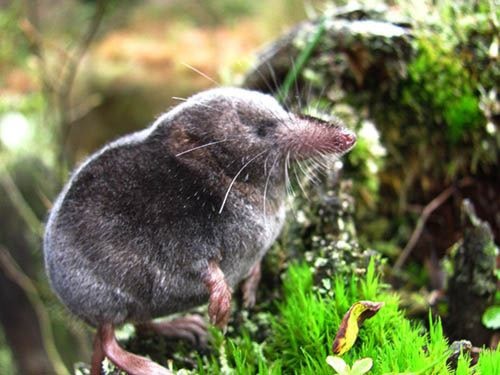They’ve got long claws and sharp teeth, are always hungry and have bad attitudes.
They also keep to themselves, which means tracking and determining their whereabouts and numbers is never easy.
A B.C. Environment survey in 1992 that captured 999 small mammals in the Fraser Valley, found only three Pacific water shrews, while a survey in 2006, tried without success to find the rodent on Blue Mountain, in east Maple Ridge.
“For their size, they’re more ferocious than a lion. They can attack and kill things their own size. They’re just so fast they can kill things in seconds,” says Denis Knopp, a wildlife surveyor.
They’re also endangered, because they happen to live in the same place where most people in B.C. live.
The natural range of the Pacific water shrew is the Lower Mainland and Fraser Valley, where roads and homes, logging and farming, continue to chew into shrew habitat.
But Knopp found one of them a year ago, in a place called Golden Pond, just a few kilometres from the streets of Maple Ridge, past the Alouette Correctional Centre for Women on the east side of Alouette Lake.
The discovery came after 20 days of setting 50 traps in the area and checking them regularly, to ensure any animals caught don’t die of starvation or hypothermia.
“It’s pretty exciting,” he says.
He had mostly given up finding the shrew and was picking up his gear when he saw the creature in one of the last traps. He grabbed it by its tail and grabbed a quick photo before it scampered off.
Knopp was part of the Pacific water shrew recovery team working with biologist and species-at-risk specialist Aimee Mitchell, who’s in the middle of a five-year survey of endangered species in the Alouette watershed, funded by B.C. Hydro.
Along with the shrew, Mitchell is trying to inventory rare plants, and the endangered great blue heron and the western painted turtle.

The Alouette watershed includes the marshlands at the north end of 224th Street, Metro Vancouver parks and the UBC Research Forest.
“This is the first species-at-risk project that they have sponsored,” Mitchell said of BC Hydro.
Mitchell is glad the little guy showed up in the trap.
“They’re a good indication of aquatic health,” says Mitchell. “And they are rare. They’re red listed.”
The Pacific water shrew depends on tiny streams that contain no fish, streams that are easily buried or excavated over when development marches in.
“They’re really slow-flowing creeks which are often not fish-bearing as well,” Mitchell points out.
“They’re often not fish-bearing, so they just get logged over. The habitat that they’re in, it does get destroyed often, as well.”
According to the Ministry of Environment’s recovery plan, streams where shrews have been found should have 100-metre protective areas on each side, while the stream should be at least 1.5 metres long. Those areas have been set aside around Golden Pond.
In recent years, only 23 sightings of the Pacific water shrew have been recorded, with last year’s sighting most recent. So it’s a significant find, adds Mitchell.
The little rodent though is just one of the treasures that Golden Pond is giving up.
The coastal tailed frog and the red-legged frog, both species at risk, are in the area. Golden Pond is so hospitable, it hosts the largest concentration of eggs for the red-legged frog in the area. This year, 160 egg masses were seen on the pond.
“It’s a very high density breeding site for red-legged frogs, the highest that I’ve ever surveyed in the Lower Mainland.
“It has all the right conditions and it’s not disturbed very much. Even though it’s right by the road, it doesn’t seem to be a lot of traffic. It doesn’t get a lot of pollution.”
The coastal tailed frog, blue listed, was spotted nearby. “They inhabit steep, coastal streams.”
It’s the only frog that breeds in rainforest streams. The tadpoles stay in fast-flowing streams for about four years so if anything happens in the streams, generations of coastal tailed frogs can be wiped out, Knopp pointed out.
Greta Borick-Cunningham, executive-director with the Alouette River Management Society, said Golden Pond has been the focus of environmental efforts for the past 15 years.
The pond used to empty into Alouette Lake (now a B.C. Hydro reservoir) until the road beside the lake separated it from the lake. Since then, the river society, Fisheries and Oceans Canada, have dug a side channel to allow coho salmon access to spawning grounds. Woody debris has been placed to provide hiding spots for fish while ARMS and the Maple Ridge Environmental School has been on the site several times, testing water quality and taking wildlife samples. Some plants and shrubs have been planted to help what used to be a camping area and signs were posted this spring telling people the shrew is in the area. “We’re relying on people to obey the signs,” said Mitchell.
A rust-skinned newt, a type of salamander, also showed up in Golden Pond.
“We haven’t come across them in the Lower Mainland. They are fairly rare in the Lower Mainland.”
